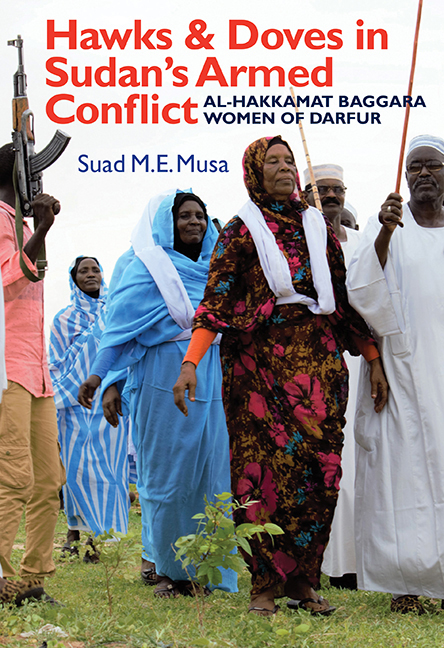Book contents
- Frontmatter
- Dedication
- Contents
- List of Illustrations
- Acknowledgements
- Glossary
- Abbreviations
- Note on Transliteration
- Introduction: Conflict in Darfur and the Role of Rural Darfuri Women
- 1 Ethnicity and Administration in Darfur
- 2 Conflict in Darfur: Causes and Implications
- 3 Al-Hakkamat Women
- 4 Local Inter-ethnic Conflicts
- 5 Government and Racial Assimilation of Ethnic Groups
- 6 Liaising with Government
- 7 New Duties and Obligations
- 8 Roles in Peace and Reconciliation
- 9 Urban Identity and Social Change
- 10 Conclusion
- Appendix: Darfur Chronology, 1445–2017
- Bibliography
- Index
- Eastern African Studies
Introduction: Conflict in Darfur and the Role of Rural Darfuri Women
Published online by Cambridge University Press: 12 October 2019
- Frontmatter
- Dedication
- Contents
- List of Illustrations
- Acknowledgements
- Glossary
- Abbreviations
- Note on Transliteration
- Introduction: Conflict in Darfur and the Role of Rural Darfuri Women
- 1 Ethnicity and Administration in Darfur
- 2 Conflict in Darfur: Causes and Implications
- 3 Al-Hakkamat Women
- 4 Local Inter-ethnic Conflicts
- 5 Government and Racial Assimilation of Ethnic Groups
- 6 Liaising with Government
- 7 New Duties and Obligations
- 8 Roles in Peace and Reconciliation
- 9 Urban Identity and Social Change
- 10 Conclusion
- Appendix: Darfur Chronology, 1445–2017
- Bibliography
- Index
- Eastern African Studies
Summary
Darfur is the westernmost region of Sudan and it extends over an area of approximately 500,000 square kilometres. Since the split of Sudan into two countries in 2011, Darfur remains the largest region of the Republic of Sudan. Like the seceding Southern Sudan region, it has also suffered prolonged armed conflict and bitter civil strife for decades, the most violent being the recent Darfuri insurgency against the National Congress Party government in Sudan. This insurgency started in early 2003 and has continued to date although active insurgency has subsided especially following the most recent battles in which the insurgents suffered heavy losses.
Like those of their southern counterparts, Darfur insurgencies were triggered by the domestic political approach to distributing power and wealth in the country. Using this approach, the riverine ruling and governing elites pursued discriminatory policies whereby the central and northern regions were favoured, leading to their economic domination and cultural hegemony being solidified to the disadvantage and negligence of the vast majority of the peripheral regions. The insurgents had seen a succession of peaceful lobbying and activism either unanswered and/or dubbed racist or subnational (geographic), which left them with no other option but to take up arms in order to seek out a just share of the wealth and power of the country, and end the patronising and discriminatory approaches and policies.
The independent Sudanese central government did not take into account the possibility that peaceful lobbying could change into boisterous and violent trends at a time when simple pre-emptive constitutionally mandated measures could have been put in place to enable justice and equality as requested by the activists (Khalid, 2009, p. 39). In fact, the current central government rejected the activists’ demands outright, and substituted condemnation for persuasion, thus refusing from the beginning to engage in dialogue and negotiation in order to redress grievances and settle differences. This approach inescapably pushed the peaceful activists to lurch further into a fully armed struggle by 2003. Systematic attacks were then launched on government strategic assets such as al-Fashir airport, which were then met with a vicious government onslaught that killed and devastated vast populations in the rural conflict zones.
- Type
- Chapter
- Information
- Hawks and Doves in Sudan's Armed ConflictAl-Hakkamat Baggara Women of Darfur, pp. 1 - 8Publisher: Boydell & BrewerPrint publication year: 2018

